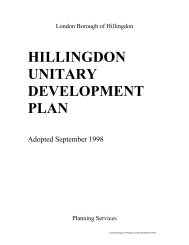Reluctant Gangsters - London Borough of Hillingdon
Reluctant Gangsters - London Borough of Hillingdon
Reluctant Gangsters - London Borough of Hillingdon
You also want an ePaper? Increase the reach of your titles
YUMPU automatically turns print PDFs into web optimized ePapers that Google loves.
1. Explaining and Defining Gangs<br />
The gang is an escalator.<br />
(Terence Thornbury, 1998)<br />
The Gang and the City<br />
Youth gangs have existed throughout recorded history and, as far<br />
as we know, everywhere in the world (Pearson, 1983, Hagedorn,<br />
2007). However, the systematic study <strong>of</strong> youth gangs only began in<br />
the United States in the early part <strong>of</strong> the 20 th Century. These early<br />
studies, conducted in Chicago by Frederick Thrasher (1963) and<br />
Robert Park (1929), were primarily concerned with the impact <strong>of</strong><br />
migration on the ‘ecology’ <strong>of</strong> the city and the apparent ‘social<br />
disorganisation’ <strong>of</strong> migrant families. They found that second<br />
generation migrant youth <strong>of</strong>ten formed gangs and that these gangs<br />
<strong>of</strong>ten broke the law. However, the researchers believed that, like<br />
the social disorganisation that supposedly blighted the lives <strong>of</strong><br />
migrant families, gangs were a temporary phenomenon that would<br />
be remedied, over time, by acculturation to, and assimilation into,<br />
the social and economic mainstream.<br />
The Gang and the Social Structure<br />
The idea that the ‘social disorganisation’ which generated street<br />
gangs was a property <strong>of</strong> particular migrant groups at a particular<br />
stage in their social and cultural development was challenged in the<br />
1960s by Richard Cloward and Lloyd Ohlin <strong>of</strong> the Columbia School<br />
<strong>of</strong> Social Work, NYC. In Delinquency and Opportunity (1960) they<br />
explored the factors that produced different kinds <strong>of</strong> gangs in<br />
different kinds <strong>of</strong> neighbourhoods. They concluded that what they<br />
called the ‘organised slum’ produced criminal gangs while the<br />
‘disorganised slum’ produced fighting gangs. And this, they argued,<br />
was because although both groups were denied legitimate<br />
opportunity, the organised slum had a well-developed criminal<br />
hierarchy that was linked into organised crime and maintained<br />
mutually beneficial relationships with the police, the Democratic<br />
Party political machine and City Hall. In short, ‘the fix was in’. The<br />
‘disorganised slum’, by contrast, was not ‘connected’ in this way,<br />
and so the only route to status was via physical prowess and<br />
illegitimate opportunity consisted <strong>of</strong> low-level opportunist street<br />
crime. Reading between the lines <strong>of</strong> Delinquency and Opportunity it<br />
is clear that, while the organised slum is inhabited by poor Whites,<br />
the disorganised slum is home to African and Hispanic Americans.<br />
The work <strong>of</strong> Cloward & Ohlin suggests that to understand the gang,<br />
we must understand the social and economic conditions and the<br />
criminal, political and administrative structures that foster its<br />
7

















